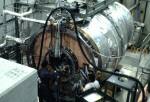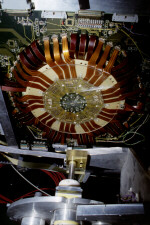



La fisica degli ioni pesanti
When time began ...
... scientists believe there was a Big Bang from which everything in the Universe emerged.
Fifteen thousand million years later, the Universe is so huge that it would take light
millions of years cross. Yet in the beginning everything was squeezed into a tiny volume
no bigger then a flea. All the particles which make up everyday matter, from which we and
everything around us are made, had yet to form. The quarks and gluons, which in today's
cold Universe are locked up inside protons and neutrons, would have been too hot to stick
together. Matter in this state is called Quark Gluon Plasma, QGP, and experiments at CERN
are trying to recreate it.
Scientists think that QGP might still exist today in the hearts of neutron stars which are
so dense that a piece the size of a pinhead would weigh as much as a thousand jumbo jets.
But even if QGP does exist there, it can't be studied, so to understand the first moments
of the Universe's life scientists must create QGP in the laboratory. To do so, they smash
ions, atoms stripped of electrons, into each other at very high energy, squeezing the
protons and neutrons together to try and make them melt. Experiments at CERN through the
1980s and 1990s have smashed ions of oxygen, sulphur and lead into stationary targets. The
results have given tantalizing hints that QGP might have been created for fleeting moments
before cooling down into ordinary matter again.
 |
| NA45 detector |
 |
| WA97 detector |
|
The lead beam programme started in 1994, after the CERN accelerators has been upgraded
by a collaboration between CERN and institutes in the Czech Republic, France, India,
Italy, Germany, Sweden and Switzerland. A new lead ion source was linked to pre-existing,
interconnected accelerators, at CERN, the Proton Synchrotron (PS) and the SPS. The seven
large experiments involved measured different aspects of lead-lead and lead-gold
collisions. They were named NA44, NA45, NA49, NA50, NA52,
WA97/NA57 and WA98. Some of these experiments use multipurpose detectors to
measure and correlate several of the more abundant observable phenomena. Others are
dedicated experiments to detect rare signatures with high statistics. This co-ordinated
effort using several complementing experiments has proven very successful. |
 |
| NA50 detector |
|
 |
At a special seminar on 10 February 2000, spokespersons from the
experiments on CERN's Heavy Ion programme presented compelling evidence for the existence
of a new state of matter in which quarks,
instead of being bound up into more complex particles such as protons and neutrons, are
liberated to roam freely. |
At CERN's next accelerator, the LHC, lead ions will collide head-on at energies 300 times
higher than at older CERN experiments. Physicists believe that at these energies making
QGP will be a matter of routine allowing physicists to study its properties in detail.
What actually happens when a QGP forms? Let's take
a look!
© Copyright CERN - Last modified on 2000-02-08 - Tradotto da Sofia Sabatti


